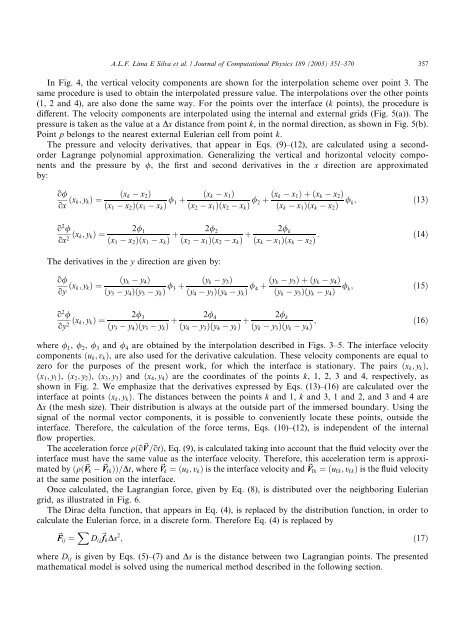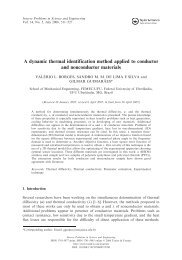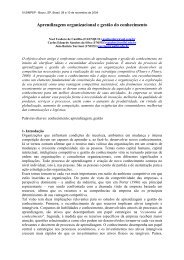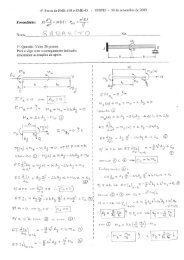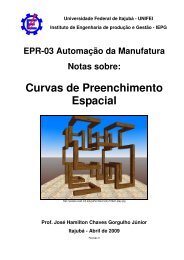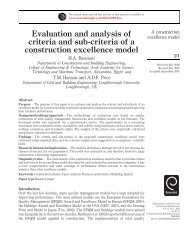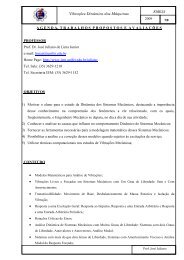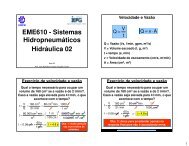Numerical simulation of two-dimensional flows over a circular ...
Numerical simulation of two-dimensional flows over a circular ...
Numerical simulation of two-dimensional flows over a circular ...
You also want an ePaper? Increase the reach of your titles
YUMPU automatically turns print PDFs into web optimized ePapers that Google loves.
In Fig. 4, the vertical velocity components are shown for the interpolation scheme <strong>over</strong> point 3. Thesame procedure is used to obtain the interpolated pressure value. The interpolations <strong>over</strong> the other points(1, 2 and 4), are also done the same way. For the points <strong>over</strong> the interface (k points), the procedure isdifferent. The velocity components are interpolated using the internal and external grids (Fig. 5(a)). Thepressure is taken as the value at a Dx distance from point k, in the normal direction, as shown in Fig. 5(b).Point p belongs to the nearest external Eulerian cell from point k.The pressure and velocity derivatives, that appear in Eqs. (9)–(12), are calculated using a secondorderLagrange polynomial approximation. Generalizing the vertical and horizontal velocity componentsand the pressure by /, the first and second derivatives in the x direction are approximatedby:o/ox ðx k; y k Þ¼ðx k x 2 Þðx 1 x 2 Þðx 1 x k Þ / ðx k x 1 Þ1 þðx 2 x 1 Þðx 2 x k Þ / 2 þ ðx k x 1 Þþðx k x 2 Þ/ðx k x 1 Þðx k x 2 Þ k ; ð13Þo 2 /ox ðx 2/k; y 2 k Þ¼1ðx 1 x 2 Þðx 1 x k Þ þ 2/ 2ðx 2 x 1 Þðx 2 x k Þ þ 2/ kðx k x 1 Þðx k x 2 Þ : ð14ÞThe derivatives in the y direction are given by:o/oy ðx k; y k Þ¼A.L.F. Lima E Silva et al. / Journal <strong>of</strong> Computational Physics 189 (2003) 351–370 357ðy k y 4 Þðy 3 y 4 Þðy 3 y k Þ / ðy k y 3 Þ3 þðy 4 y 3 Þðy 4 y k Þ / 4 þ ðy k y 3 Þþðy k y 4 Þ/ðy k y 3 Þðy k y 4 Þ k ; ð15Þo 2 /oy ðx 2/k; y 2 k Þ¼3ðy 3 y 4 Þðy 3 y k Þ þ 2/ 4ðy 4 y 3 Þðy 4 y k Þ þ 2/ kðy k y 3 Þðy k y 4 Þ ; ð16Þwhere / 1 , / 2 , / 3 and / 4 are obtained by the interpolation described in Figs. 3–5. The interface velocitycomponents ðu k ; v k Þ, are also used for the derivative calculation. These velocity components are equal tozero for the purposes <strong>of</strong> the present work, for which the interface is stationary. The pairs ðx k ; y k Þ,ðx 1 ; y 1 Þ, ðx 2 ; y 2 Þ, ðx 3 ; y 3 Þ and ðx 4 ; y 4 Þ are the coordinates <strong>of</strong> the points k, 1, 2, 3 and 4, respectively, asshown in Fig. 2. We emphasize that the derivatives expressed by Eqs. (13)–(16) are calculated <strong>over</strong> theinterface at points ðx k ; y k Þ. The distances between the points k and 1, k and 3, 1 and 2, and 3 and 4 areDx (the mesh size). Their distribution is always at the outside part <strong>of</strong> the immersed boundary. Using thesignal <strong>of</strong> the normal vector components, it is possible to conveniently locate these points, outside theinterface. Therefore, the calculation <strong>of</strong> the force terms, Eqs. (10)–(12), is independent <strong>of</strong> the internalflow properties.The acceleration force qðo~V =otÞ, Eq. (9), is calculated taking into account that the fluid velocity <strong>over</strong> theinterface must have the same value as the interface velocity. Therefore, this acceleration term is approximatedby ðqð~V k~V fk ÞÞ=Dt, where ~V k ¼ðu k ; v k Þ is the interface velocity and ~V fk ¼ðu fk ; v fk Þ is the fluid velocityat the same position on the interface.Once calculated, the Lagrangian force, given by Eq. (8), is distributed <strong>over</strong> the neighboring Euleriangrid, as illustrated in Fig. 6.The Dirac delta function, that appears in Eq. (4), is replaced by the distribution function, in order tocalculate the Eulerian force, in a discrete form. Therefore Eq. (4) is replaced by~F ij ¼ X D ij~ fk Ds 2 ; ð17Þwhere D ij is given by Eqs. (5)–(7) and Ds is the distance between <strong>two</strong> Lagrangian points. The presentedmathematical model is solved using the numerical method described in the following section.


